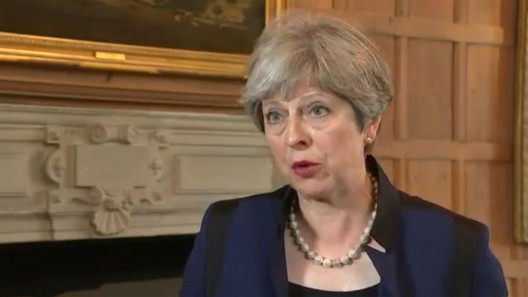
The date, it seems, is set. British Prime Minister Theresa May will depart on August 30, 2019, or so it is confidently reported. After a smooth Brexit, she can leave Downing Street with elegant aplomb at that time of her own choosing. Really? Magical thinking indeed.
In post-war times, vanishingly few prime ministers have exited voluntarily — all but Harold Wilson were ejected either by voters or their own party, some brutally knifed full-frontal (Margaret Thatcher) or others (Tony Blair) with a pistol at their back. Nothing about May, the most precarious and accidental prime minister, suggests she commands her destiny.
“Peak silly season”, sniffs Downing Street at these unsourced reports, and I agree: Whether this is an authentic May desire or some Tory MP’s fabrication, it’s pure fantasy. One thing we know for sure is that we know nothing about the unpredictable course of the next Brexit-fraught 18 months, soft, harder or into the abyss. As Britain’s Brexit Secretary David Davis sat down again opposite Michel Barnier, the European Chief Negotiator for Brexit, on Monday, still thrashing out the most elementary first steps, we can only marvel at how May has wasted 14 precious months since the referendum, still with no clear intent and no vision, let alone a route map. Seven position papers in recent weeks have left everything as vague and wishful as ever, MC Escher drawings pretending to “constructive ambiguity”, cake-and-eat-it crumbs on every page.
This week brings another relaunch of the May ship, ahead of a turbulent Tory party conference. With prosecco and chocolates, she is greeting platoons of Tory MPs at Chequers in a “charm offensive” designed to ward off leadership challenges. As a rare senior politician who lacks the rudiments of charm, and who is devoid of small talk or indeed big talk either, we can only imagine the excruciating awkwardness of these group encounters. Socially, she makes Edward Heath or Gordon Brown seem the soul of wit and gregarious ease.
What symbol best embodies her prime ministership? Her ship of state is the Queen Elizabeth, the aircraft carrier with no aircraft , costing much more than was ever intended, an empty vessel going nowhere.
But Grenfell Tower may forever be the emblem of her austerity era, as the Notting Hill carnival on Monday passed under its shadow. That image of her belated visit — encircled by protective officers, unable, unwilling, fearing to meet survivors — will flash up time and again in her political obsequies. She who once said she’d make the Conservatives the “workers’ party” dared not meet one ordinary person in her hermetically sealed election campaign of doom.
Today’s attempt to change the conversation from her never-ending Brexit contradictions sees the prime minister return to the theme of her early speeches on social justice, challenging the “unacceptable face of capitalism”. Her tough attack in the Mail on Sunday on the “excesses and irresponsibility” of fat cat top pay warns that their greed undermines faith in free enterprise and damages “the social fabric of our country”. Fighting talk.
But yet again, expect the same strange dissonance between her words and her actions, as if someone else writes her speeches and articles and she has no idea what’s in them nor any intention of obeying them. Gone is her previous promise to put workers on company boards and give shareholders real power to rein in top pay. There will be no legislation, reports the Financial Times, leaving the City to self-regulate greater pay transparency, with a register of companies where 20 per cent of shareholders voted down executive pay. Vince Cable, who as business secretary brought in binding shareholder votes on top pay, dismisses May’s gestures as “strong on rhetoric, weak on action”. This is thin gruel to distract us from the two great Tory disasters — Brexit and austerity.
Can she last? These days, no one sensible makes political predictions. Wavering gnomically between her party’s warring factions, she has no friends, nor does she build alliances, either in her cabinet or among any of the 27 European Union (EU) leaders who hold her — and our — fate in their hands.
Her deputy, her chancellor and her home secretary are all Remainers, determined to hold her back from Brexit disaster. Why she leans so far to her Brexit wing is a mystery, but until now, she has given them the whip hand. By failing to slap down Boris Johnson, Britain’s Foreign Secretary, for his fatuous “go whistle” jibe, she sanctioned him to stir maximum anger among EU countries who must pay in for every pound less we contribute.
Ineptitude? Dithering? Fear of Brexiteer ferocity? She remains an enigma — though not a very interesting one. The worry is that beneath the sphinx-like exterior there is no great riddle, not much in brain, vision, ingenuity or political grasp. Her cabinet colleagues were always bemused by her obstinacy, even in the face of overwhelming factual evidence. Her refusal to take foreign students out of immigration numbers has been utterly perplexing: Sticking to it despite new proof that they are indeed students who go home, not migrants, defies all political sense.
That rigidity of mind augurs badly as evidence pours in from every sector of ill-effects the Europhobes ignored in their 40-year ideological campaign. Now Britain has just 18 months to renegotiate 759 complex EU arrangements with 168 other countries on every conceivable topic. No sign yet she has taken fright at any of this, nor at the falling pound, productivity and export gap, or at growth trailing the Eurozone.
It may be that, like a jellyfish, she has little independent propulsion but is blown along by the tides. If so, she may start drifting the other way on Brexit, thanks to Labour’s timely demarche. Keir Starmer has finally convinced his leaders that Labour must stand for staying in the single market and customs union, under the European court of justice, with free movement, unless and until something better is negotiated (if ever). With her slender majority, the 30 or more strong Tory Remainer MPs don’t need to threaten: May knows they are there, glaring at her. The tide just turned.
Will she still be there on August 30, 2019? Who knows how she will weather the great Brexit tempest ahead. But I fear that if the time comes when a brave prime minister needs to stand up for the good of the country against her own fractious party, there will be no point looking in her direction: Theresa May is not the leader with the guts or vision to do it.
— Guardian News & Media Ltd
Polly Toynbee is a Guardian columnist.








